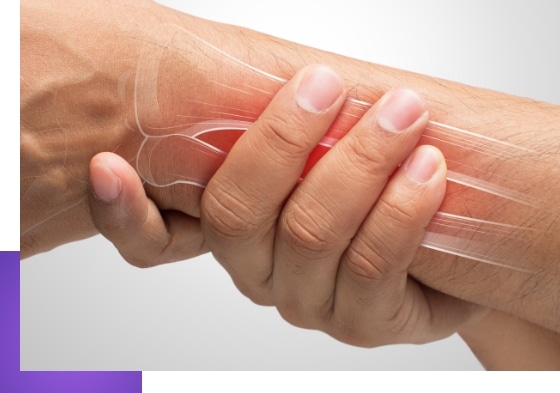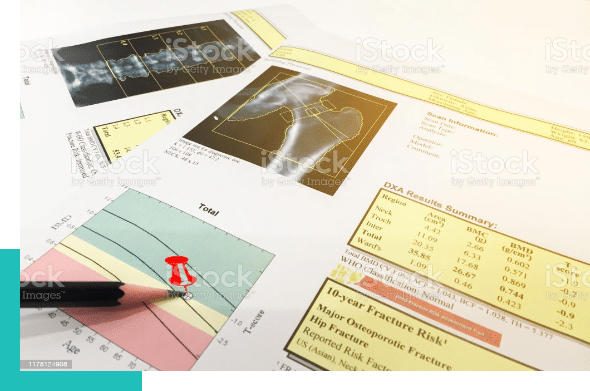Why Bone Score?
Independent Clinical Research from around the world demonstrates the value of Bone Score
Lower Bone Scores are associated with Fragility
In contrast to traditional approaches to fracture risk assessment using clinical risk factors and bone mineral density (BMD), a new technique, Bone Score, permits direct assessment of bone tissue. Bone Score measurements discriminate patients with a fragility fracture from controls. Bone Scores are lower for osteoporotic fracture patients than controls (p < 0.001), which persisted with adjustment for age, sex, body mass index (BMI), and height (p < 0.001).
https://www.ncbi.nlm.nih.gov/pubmed/26235931
J Bone Miner Res. 2016 Jan;31(1):196-203. doi: 10.1002/jbmr.2605. Epub 2015 Oct 6.
Low Bone Scores are associated with increased risk of all osteoporotic fractures and the severity of vertebral fractures.
https://www.ncbi.nlm.nih.gov/pubmed/28246929
Calcif Tissue Int. 2017 Jul;101(1):34-42. doi: 10.1007/s00223-017-0256-5. Epub 2017 Feb 28.
Lower Bone Scores are associated with increased risk of distal radius fracture, and remained statistically significant after adjustment for age, age and BMI, and age, BMI, and FN BMD (OR = 1.48 to 1.55). Lower Bone Scores tended to be associated with hip fracture, but only reached borderline significance (unadjusted OR = 1.39; 95% CI, 0.96 to 2.01, p = 0.08). These results provide strong rationale for future investigations aimed at assessing whether BMSi can predict fracture in prospective studies and improve identification of women at risk for fragility fractures.
https://www.ncbi.nlm.nih.gov/pubmed/29115684
J Bone Miner Res. 2018 Apr;33(4):621-626. doi: 10.1002/jbmr.3338. Epub 2017 Dec 5.
Bone Scores were lower in patients with a fragility fracture compared with nonfracture patients despite similar BMD. Bone Scores were comparable in patients with a fragility fracture whether they had osteopenia or osteoporosis. In patients with osteopenia, Bone Scores were significantly lower in fracture patients than in nonfracture patients.
https://www.ncbi.nlm.nih.gov/pubmed/25768670
J Clin Endocrinol Metab. 2015 May;100(5):2039-45. doi: 10.1210/jc.2014-4346. Epub 2015 Mar 13.
Patients with type 2 diabetes display a unique skeletal phenotype with either normal or more frequently increased, bone mineral density and impaired structural and geometric properties. Recently, alterations in bone material properties seem to be the predominant defect leading to increased bone fragility. Accumulation of advanced glycation end-products and changes in collagen cross-linking along with suppression of bone turnover seem to be significant factors impairing bone strength. FRAX score has been reported to underestimate fracture risk and lumbar spine BMD is inadequate in predicting vertebral fractures.
https://www.ncbi.nlm.nih.gov/pubmed/25284729
Metabolism. 2014 Dec;63(12):1480-90. doi: 10.1016/j.metabol.2014.09.002. Epub 2014 Sep 28.


Measure the effects of Treatments
Glucocorticoids, widely used in inflammatory disorders, rapidly increase bone fragility and, therefore, fracture risk. However, common bone densitometry measurements are not sensitive enough to detect these changes. Moreover, densitometry only partially recognizes treatment-induced fracture reductions in osteoporosis. Patients were allocated into groups receiving calcium + vitamin D (Ca+D) supplements or anti-osteoporotic drugs (risedronate, denosumab, teriparatide) and measured BMD and Bone Scores. Although Ca+D-treated patients exhibited substantial and significant deterioration, risedronate-treated patients exhibited no significant change, and both denosumab- and teriparatide-treated participants exhibited significantly improved Bone Scores 7 weeks after initial treatment compared with baseline; these trends remained stable for 20 weeks. In contrast, no densitometry changes were observed during this study period.
J Bone Miner Res. 2015 Sep;30(9):1651-6. doi: 10.1002/jbmr.2497. Epub 2015 Jun 11.
End-stage renal disease patients undergoing transplant surgery have damaged bone health parameters (density, microarchitecture, and mechanical properties) despite acceptably controlled hyperparathyroidism. To treat these patients, a kidney transplant is needed. Detecting abnormalities in the bone of kidney transplant patients may assist in identifying patients at high risk of post-transplantation fractures.
https://www.ncbi.nlm.nih.gov/pubmed/28497224
Osteoporos Int. 2017 Sep;28(9):2723-2727. doi: 10.1007/s00198-017-4065-5. Epub 2017 May 11.
Despite persistent decrease in BMD, trabecular microarchitecture and Bone Scores remain normal in long-term kidney transplant recipients, suggesting important recovery of bone health.
https://www.ncbi.nlm.nih.gov/pubmed/27467533
Transplantation. 2017 Jun;101(6):1290-1294. doi: 10.1097/TP.0000000000001328.
Most fractures occur in patients without Osteoporosis
Although low bone mineral density (BMD) is strongly associated with increased fracture risk, up to 50% of those who suffer fractures are not detected as high-risk patients by BMD testing. Thus, new approaches may improve identification of those at increased risk for fracture by in vivo assessment of altered bone tissue properties, which may contribute to skeletal fragility.
https://www.ncbi.nlm.nih.gov/pubmed/25862290
Bone. 2018 Jan;106:90-95. doi: 10.1016/j.bone.2015.03.021. Epub 2015 Apr 7.

Fracture Risk is Multifaceted
The assessment of fracture risk often relies primarily on measuring bone mineral density, thereby accounting for only a single pathology: the loss of bone mass. However, bone’s ability to resist fracture is a result of its biphasic composition and hierarchical structure that imbue it with high strength and toughness.
https://www.ncbi.nlm.nih.gov/pubmed/27021150
Bone. 2016 Jun;87:37-43. doi: 10.1016/j.bone.2016.03.013. Epub 2016 Mar 26.
Measure the effects of Exercise
Bone adapts to loading in several ways, including redistributing bone mass and altered geometry and microarchitecture. Because of previous methodological limitations, it is not known how the bone material strength is affected by mechanical loading in humans. A unilateral high-impact loading program increased Bone Scores in postmenopausal women rapidly without affecting bone microstructure, geometry, or density, indicating that intense mechanical loading has the ability to rapidly improve bone material properties before changes in bone mass or structure.
https://www.ncbi.nlm.nih.gov/pubmed/29578618
J Bone Miner Res. 2018 Jul;33(7):1242-1251. doi: 10.1002/jbmr.3431. Epub 2018 Apr 27
